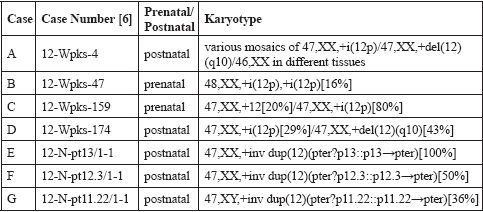


PALLISTER-KILLIAN SYNDROME: RARE PHENOTYPIC FEATURES AND VARIABLE KARYOTYPES
Liehr T1,*, Wegner R-D2, Stumm M2, Joksic G3, Polityko A4,Kosyakova N1, Ewers E1, Reich D1, Wagner R1, Weise A1
*Corresponding Author: Dr. Thomas Liehr, Institut für Humangenetik, Postfach D-07740 Jena,
Germany; Tel: +49-3641-935533; Fax. ++49-3641-935582; e-mail: i8lith@mti.uni-jena.de
page: 65
download article in pdf format
|
|
Abstract
The Pallister-Killian Syndrome (PKS; OMIM #601803), also known as Tetrasomy 12p or Mosaic Isochromosome 12p syndrome, is a rare genetic disorder in humans. Its exact incidence is not known. The PKS is due to a partial tetrasomy of the whole, or parts of, the short arm of chromosome 12. It was first described by Philip Pallister in 1977 and further studied by Maria Teschler-Nicola and W. Killian in 1981. Prenatally, PKS can be suggested due to relatively unspecific abnormal sonographic findings such as enhanced nuchal transluciency or abnormal hands or feet, as well as omphalocele. In a newborn or small child, PKS can be diagnosed with facial anomalies, streaks of hypo- or hyper-pigmentation, seizures and profound mental retardation. Characteristic for PKS is a tissue-limited mosaicism; i.e., most fibroblasts have 47 chromosomes with an extra small metacentric iso-chromosome i(12)(p10), whereas the karyotype in the majority of the lymphocytes is normal (see OMIM #601803).
Even though PKS is a well-known syndrome in most recent reports [1-4], the authors are not aware of the number of previously published cases. As reviewed on the regularly updated homepage on small supernumerary marker chromosomes (sSMC) [5] on the sub-page for PKS [6], there were, up to November 2008, 103 prenatal and 129 postnatal PKS reported in the literature, including the five new prenatal cases summarized in Table 1.

Thus, of the four well-defined syndromes characterized by an sSMC, PKS is the second most frequently reported (8.4%) (this frequency is deduced from the data collected in Ref. 5), after Emanuel Syndrome (OMIM #609029) and ahead of isochromosome 18p syndrome [7] and cat eye syndrome (OMIM #115470).
More interesting is, that a variety of karyotypes have been reported in association with PKS, besides the regular ones with 47,+i(12p) and mos 47,+i(12p)/46. Unexpected cytogenetic results are sometimes detected even though the PKS phenotype is clear (Table 2) or there is no sSMC [8]. In PKS with sSMC, more complex mosaics have been reported as in cases A-D of Table 2, including complete trisomy 12 and hexasomy 12p. Three cases (E-G) in Table 2 with neocentric sSMC (12) suggest a possible small PKS critical region in 12pter to 12p13. Thus, additional case reports can be expected to further increase our clinical and cytogenetic understanding of PKS. Nonetheless, to come to an approximate assessment of the frequency of PKS in the general population, also cases with a "typical Tetrasomy 12p" karyotype, should be reported, as the five of the present paper.

|
|
|
|



 |
Number 27
VOL. 27 (2), 2024 |
Number 27
VOL. 27 (1), 2024 |
Number 26
Number 26 VOL. 26(2), 2023 All in one |
Number 26
VOL. 26(2), 2023 |
Number 26
VOL. 26, 2023 Supplement |
Number 26
VOL. 26(1), 2023 |
Number 25
VOL. 25(2), 2022 |
Number 25
VOL. 25 (1), 2022 |
Number 24
VOL. 24(2), 2021 |
Number 24
VOL. 24(1), 2021 |
Number 23
VOL. 23(2), 2020 |
Number 22
VOL. 22(2), 2019 |
Number 22
VOL. 22(1), 2019 |
Number 22
VOL. 22, 2019 Supplement |
Number 21
VOL. 21(2), 2018 |
Number 21
VOL. 21 (1), 2018 |
Number 21
VOL. 21, 2018 Supplement |
Number 20
VOL. 20 (2), 2017 |
Number 20
VOL. 20 (1), 2017 |
Number 19
VOL. 19 (2), 2016 |
Number 19
VOL. 19 (1), 2016 |
Number 18
VOL. 18 (2), 2015 |
Number 18
VOL. 18 (1), 2015 |
Number 17
VOL. 17 (2), 2014 |
Number 17
VOL. 17 (1), 2014 |
Number 16
VOL. 16 (2), 2013 |
Number 16
VOL. 16 (1), 2013 |
Number 15
VOL. 15 (2), 2012 |
Number 15
VOL. 15, 2012 Supplement |
Number 15
Vol. 15 (1), 2012 |
Number 14
14 - Vol. 14 (2), 2011 |
Number 14
The 9th Balkan Congress of Medical Genetics |
Number 14
14 - Vol. 14 (1), 2011 |
Number 13
Vol. 13 (2), 2010 |
Number 13
Vol.13 (1), 2010 |
Number 12
Vol.12 (2), 2009 |
Number 12
Vol.12 (1), 2009 |
Number 11
Vol.11 (2),2008 |
Number 11
Vol.11 (1),2008 |
Number 10
Vol.10 (2), 2007 |
Number 10
10 (1),2007 |
Number 9
1&2, 2006 |
Number 9
3&4, 2006 |
Number 8
1&2, 2005 |
Number 8
3&4, 2004 |
Number 7
1&2, 2004 |
Number 6
3&4, 2003 |
Number 6
1&2, 2003 |
Number 5
3&4, 2002 |
Number 5
1&2, 2002 |
Number 4
Vol.3 (4), 2000 |
Number 4
Vol.2 (4), 1999 |
Number 4
Vol.1 (4), 1998 |
Number 4
3&4, 2001 |
Number 4
1&2, 2001 |
Number 3
Vol.3 (3), 2000 |
Number 3
Vol.2 (3), 1999 |
Number 3
Vol.1 (3), 1998 |
Number 2
Vol.3(2), 2000 |
Number 2
Vol.1 (2), 1998 |
Number 2
Vol.2 (2), 1999 |
Number 1
Vol.3 (1), 2000 |
Number 1
Vol.2 (1), 1999 |
Number 1
Vol.1 (1), 1998 |
|
|

